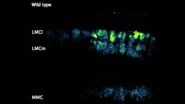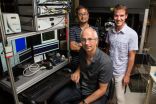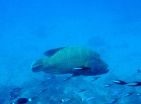(Press-News.org) LA JOLLA--When you're taking a walk around the block, your body is mostly on autopilot--you don't have to consciously think about alternating which leg you step with or which muscles it takes to lift a foot and put it back down. That's thanks to a set of cells in your spinal cord that help translate messages between your brain and your motor neurons, which control muscles.
Now, for the first time, researchers have created a method to watch--in real time--the activity of those motor neurons. The new technology, developed by Salk scientists and published in Neuron, is helping researchers understand how spinal cord cells make connections with motor neurons, and how clinicians might be able to repair those connections in patients with spinal cord injuries or neurodegenerative diseases like amyotrophic lateral sclerosis (ALS).
"Using optical methods to be able to watch neuron activity has been a dream over the past decade," says Samuel Pfaff, a professor in Salk's Gene Expression Laboratory. "Now, it's one of those rare times when the technology is actually coming together to show you things you hadn't been able to see before."
In the past, to measure the activity of neurons--whether in the brain or extending throughout the body--scientists relied on electrodes that could detect the change in electrical voltage inside a cell when it's activated. But it is tricky to use electrodes to simultaneously record the activity of many different neuron types at once to study how their activity is synchronized.
To get around this shortcoming of electrode readings, Pfaff's team used a fluorescent sensor protein called GCaMP6f that lights up whenever a neuron is activated. Unlike the electrodes, the protein could easily be added to many different cells at once. When Pfaff and his colleagues added GCaMP6f to motor neurons, they could watch with a microscope which cells were activated in a mouse spinal cord when chemicals that turn on walking circuits were added.
"You don't need to do any kind of post-image processing to interpret this," says Pfaff. "These are just raw signals you can see through the eyepiece of a microscope. It's really a jaw-dropping kind of visualization for a neuroscientist."
Pfaff's group used the new method to answer a long-standing question about how a collection of cells in the spinal cord, called the locomotor central pattern generator (CPG), connects to the right motor neurons to allow movements like walking. The CPG, Pfaff says, is where relatively simple signals from the brain--to walk forward, or move your hand off a hot stove--are translated into more complex instructions for motor neurons to control muscles.
"Our nervous system has to make decisions and computations to tell different muscles to contract, or when not to contract, or the amount of force and speed to use when contracting," Pfaff explains. It's the CPG that helps make many of these computations, scientists believe. So normal movement requires that CPG neurons in the spinal cord connect to and control when motor neurons fire. But, until now, researchers didn't know exactly how the CPG cells forged these connections.
By tweaking the locations and identities of motor neurons, and then watching the resulting patterns of activation using their new fluorescent technique, Chris Hinckley in the Pfaff laboratory found that the CPG didn't rely solely on the cells' locations to connect to them. Instead, the genetic identity of each subtype of cells--what makes those that control the quadriceps muscle different from those that control the calf muscle for instance--is also important.
That's a key finding, Pfaff says, for research on how to treat spinal cord injuries and ALS. Currently, many scientists are attempting to turn stem cells into motor neurons, which they then implant into the spinal cord to regenerate damaged connections. Pfaff's new results, though, suggest that general motor neurons might not do the trick--the best treatment may require the right subtypes of motor neurons. More work, however, is needed to understand the implications of this and exactly how it might translate to disease treatment.
INFORMATION:
Other researchers on the study were Joseph D. Dekker and Haley O. Tucker of The University of Texas at Austin; and Christopher A. Hinckley, William A. Alaynick, Benjamin W. Gallarda, Marito Hayashi, Kathryn L. Hilde, Shawn P. Driscoll and Tatyana O. Sharpee of the Salk Institute.
The work and the researchers involved were supported by grants from the National Institutes of Health, Howard Hughes Medical Institute, the Christopher and Dana Reeve Foundation, the Sol Goldman Trust and the Marshall Heritage Foundation. Pfaff is an HHMI investigator and the Benjamin H. Lewis chair in Neuroscience at the Salk Institute for Biological Studies.
About the Salk Institute for Biological Studies:
The Salk Institute for Biological Studies is one of the world's preeminent basic research institutions, where internationally renowned faculty probes fundamental life science questions in a unique, collaborative and creative environment. Focused both on discovery and on mentoring future generations of researchers, Salk scientists make groundbreaking contributions to our understanding of cancer, aging, Alzheimer's, diabetes and infectious diseases by studying neuroscience, genetics, cell and plant biology, and related disciplines. Faculty achievements have been recognized with numerous honors, including Nobel Prizes and memberships in the National Academy of Sciences. Founded in 1960 by polio vaccine pioneer Jonas Salk, MD, the Institute is an independent nonprofit organization and architectural landmark.
Georgia Institute of Technology researchers have developed a new artificially intelligent system that crowdsources plots for interactive stories, which are popular in video games and let players choose different branching story options.
With potentially limitless crowdsourced plot points, the system could allow for more creative stories and an easier method for interactive narrative generation. Current AI models for games have a limited number of scenarios, no matter what a player chooses. They depend on a dataset already programmed into a model by experts.
Using ...
Tropical Storm Fred is losing its punch. Satellite imagery shows that there are no strong thunderstorms developing in the tropical storm indicating that the storm is weakening.
The RapidScat instrument that flies aboard the International Space Station measured Tropical Storm Fred's winds on September 1 at 4 a.m. EDT. RapidScat saw that the strongest winds tightly circled the center and were on the northern side of the storm, as strong as 24 and 27 meters per second (53.6 mph/ 86.4 kph and 60.4/97.2 kph).
On September 1 at 13:00 UTC (9 a.m. EDT) the MODIS instrument ...
GeoSpace
High water tables can be a boon to crop yields
A high water table - usually a bane to crop yields - can provide much-needed water during drought and to crops planted in coarse-grained soils, found a new study published online in Water Resources Research.
3-D maps illustrate formation of the Hangai Dome in central Mongolia
Scientists used 1.7 million seismic wave measurements from 227 earthquakes across East Asia to create animated 3-D images of subsurface rock formations under the Hangai Dome in central Mongolia as part of their recent study accepted in Geophysical ...
A new study by WCS (Wildlife Conservation Society) has found that coral reef diversity 'hotspots' in the southwestern Indian Ocean rely more on the biomass of fish than where they are located, a conclusion that has major implications for management decisions to protect coral reef ecosystems.
Using data gathered over a 12-year period from nearly 270 coral reefs across the southwestern Indian Ocean, the WCS study found that the highest conservation priorities in the region should be reef systems where fish biomass exceeds 600 kilograms per hectare. This finding conflicts ...
Can water ever be too clean? If the intent is to store it underground, the answer, surprisingly, is yes. In a new study, Stanford scientists have shown that recycled water percolating into underground storage aquifers in Southern California picked up trace amounts of arsenic because the water was too pure.
The research, published online in the journal Environmental Science & Technology, sheds light on a poorly understood aspect of groundwater recharge with purified recycled water, namely the potential mobilization of arsenic. Arsenic is a naturally occurring element that ...
ATLANTA - Sept. 2, 2015 - The number of men with breast cancer who undergo surgery to remove the unaffected breast has risen sharply, according to a new report by American Cancer Society and Dana Farber Cancer Institute researchers. The report, appearing in JAMA Surgery, is the first to identify the trend, which mirrors a trend seen in U.S. women over the past two decades.
Breast cancer in men is rare, accounting for only about 1 percent of all cases in the United States. In women (particularly younger women), the use of contralateral prophylactic mastectomy (CPM) surgery ...
Genes are not only important for regular memory performance, but also for the development of Alzheimer's disease. Researchers at the University of Basel now identified a specific group of genes that plays a central role in both processes. This group of molecules controls the concentration of calcium ions inside the cell. Their results appear in the current issue of the journal JAMA Psychiatry.
Intact memory capacity is crucial for everyday life. This fact becomes apparent once a memory disorder has developed. Alzheimer's disease is the most common cause of age-associated ...
WASHINGTON, DC, September 2, 2015 -- Social scientists have long argued documentary films are powerful tools for social change.
But a University of Iowa (UI) sociologist and his co-researchers are the first to use the Internet and social media to systematically show how a documentary film reshaped public perception and ultimately led to municipal bans on hydraulic fracking.
By measuring an uptick in online searches as well as social media chatter and mass media coverage, Ion Bogdan Vasi, an associate professor of sociology at the UI and corresponding author of a new ...
A new study of more than 300 women suggests that exposure to certain phthalates -- substances commonly used in food packaging, personal-care and other everyday products -- could be associated with miscarriage, mostly between 5 and 13 weeks of pregnancy. The research, appearing in the ACS journal Environmental Science & Technology, is the first epidemiological study on non-work-related exposure to phthalates to provide evidence for the possible link among a general population.
Out of concern over the potential health effects of phthalates, the U.S. has banned six of these ...
Scientific experiments examining what happens to the faulty channel protein that causes cystic fibrosis during inflammation have yielded unexpected and exciting results. The study, conducted by Sara Bitam and her colleagues at INSERM in France, has just passed peer review on open science publishing platform F1000Research.
Cystic fibrosis is a life-limiting auto¬somal recessive monogenic disorder that affects 1 in every 2000 - 3500 newborns in the EU and US per year. It is caused by mutations in the gene that encodes the CFTR protein, an epithelial ion channel involved ...




